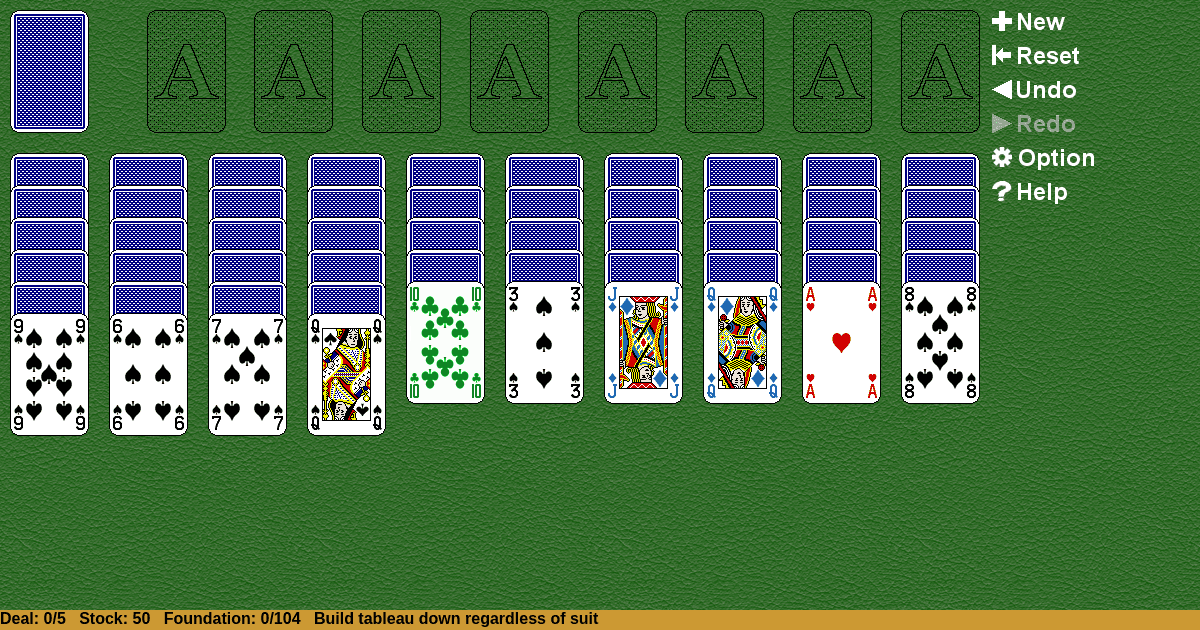Spider
Home |
How to play |
FAQ |
About
How to play Spider?
Game Objective:
The primary goal of Spider Solitaire is to assemble eight complete sequences of cards in descending order from King down to Ace within the tableau columns, with all cards in each sequence belonging to the same suit. Once a complete sequence is formed, it is automatically removed from the tableau. The game is won when all cards have been removed by creating these eight full sequences.
Setup & Layout:
- Deck: Spider Solitaire uses two standard 52-card decks, totaling 104 cards.
- Tableau: The main play area consists of 10 tableau columns.
- The first 4 columns each receive 6 cards.
- The remaining 6 columns each receive 5 cards.
- Only the top card of each tableau column is dealt face-up; all other cards in the columns are face-down.
- Stock: The remaining 50 cards are placed face-down in the stock pile (sometimes called the "stock"), which will be used to deal additional cards during gameplay.
- Foundations: There are no separate foundation piles; completed sequences are removed from the tableau automatically.
- Key Play Areas:
- Tableau: The ten columns where all play occurs.
- Stock: The pile from which new cards are dealt to the tableau.
Spider Solitaire Rules:
- Card Movement:
- Cards can be moved one at a time or in a group, provided the group forms a descending sequence (e.g., 9-8-7) and, for group moves, all cards in the group are of the same suit.
- Any face-up card can be moved onto another face-up card that is one rank higher, regardless of suit in the one-suit version, but only same-suit sequences can be moved as a group in multi-suit versions.
- Building Sequences:
- Sequences must be built in strict descending order (King, Queen, Jack, 10, …, Ace).
- In one-suit Spider Solitaire, suit does not matter for building; in two- or four-suit versions, only cards of the same suit can form a complete, movable sequence.
- Only complete, same-suit sequences from King to Ace are removed from the tableau.
- Revealing Cards:
- When a face-up card is moved, the card directly beneath it in the column is turned face-up.
- Moving to Empty Columns:
- Any single card or valid sequence can be moved to an empty tableau column.
Gameplay:
- Move face-up cards within the tableau to build descending sequences and expose face-down cards.
- Move groups of cards if they form a valid descending, same-suit sequence.
- When a complete sequence (King through Ace of the same suit) is formed in a tableau column, it is automatically removed from the tableau.
- Dealing from the Stock:
- When no further moves are possible or at the player's discretion, deal 10 new cards (one per tableau column) from the stock pile.
- Dealing is only allowed if there are no empty tableau columns; each column must contain at least one card.
- If no legal moves remain and the stock is depleted, the game ends.
Winning & Losing Conditions:
- Winning Condition:
- The game is won when all 104 cards have been removed from the tableau by forming and removing eight complete sequences of the same suit in descending order from King to Ace.
- Losing/Unwinnable Condition:
- The game is lost or becomes unwinnable if no legal moves remain and the stock is empty, making it impossible to complete all eight sequences.
Special Rules & Edge Cases:
- Filling Empty Columns:
- Any single card or valid sequence may be moved to an empty tableau column.
- Stock cannot be dealt if there is any empty tableau column; all columns must contain at least one card before dealing new cards from the stock.
- Suit Variants:
- One-suit: All cards are of the same suit, making the game easier.
- Two-suit: Two suits are used, increasing difficulty.
- Four-suit: All four suits are used, making the game most challenging.
- Revealing Cards:
- Each time a face-up card is moved, the card beneath it (if any) is immediately turned face-up.
- Sequence Movement Restrictions:
- Only same-suit descending sequences can be moved as a group; mixed-suit sequences must be rearranged before moving as a group.
- Automatic Removal:
- Completed sequences (King to Ace, same suit) are automatically removed from the tableau; there is no manual movement to a foundation.
- Stock Dealing Limit:
- The stock contains 50 cards, allowing for exactly five deals of 10 cards each during the game.
- Edge Case—No Moves Possible:
- If no moves are possible and the stock is depleted, the game ends immediately in a loss.
This guide provides a comprehensive, semantically precise explanation of the rules and gameplay mechanics for Spider Solitaire, strictly focused on play procedure and official rules.

Solitaire Collection
About Spider
Rate (Spider)
4.7 / 5
1,916 votes



























































